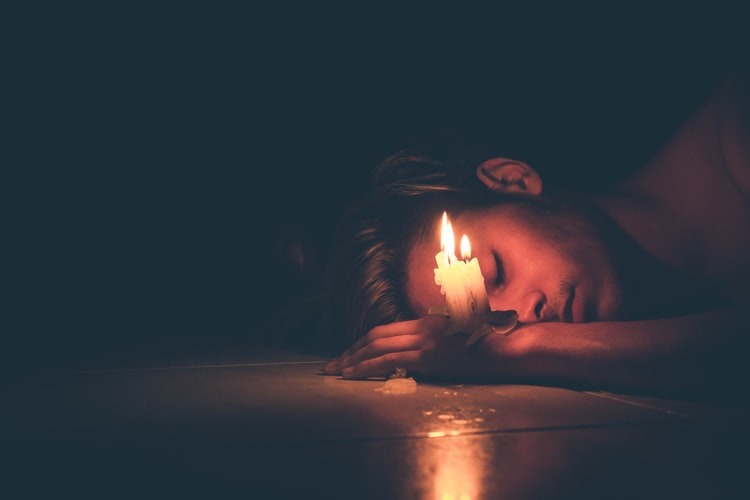The anxiety – Can we stop being anxious willingly? If yes, then How to overcome Anxiety? Nature never does anything random. In the evolution of humanity, everything has a positive objective. Most of the psychic symptoms appear as a consequence of the excess of something good that is deteriorating and transforming in a bad context or due to an overdose of something that can be painful or disturbing.
This is valid for the feeling of anxiety. In this article, we propose some references from the self-help program to explain how an overdose of anxiety appears and how one can get rid of this harmful anxiety.
What is the function of the feeling of anxiety?
Anxiety is an emotion or a feeling? – Whatever, how can we possibly overcome or stop that thing…
The function of each ’emotion’ is to provoke a necessary behavior that helps us to (over) live better in nature. The word ’emotion’ comes from the Latin verb ’emovere’ which comes to mean to displace, to put ‘in motion’ a behavior.
In this way, the emotion ‘love’ is going to set in motion, to activate, the behavior that is going to allow two people to move towards each other. The feeling of ‘anger’ is going to give rise to behavior that will make people reject each other. As we can see, each feeling has a useful function.

What then is the useful function of the feeling of anxiety?
Anxiety encourages preventive behavior. Anxiety is a useful feeling that – in principle – helps people avoid real danger. Anxiety increases the chances of surviving in the wild when dangerous situations arise. If a person encounters a hungry tiger, anxiety is a healthy reaction considering that the behavior will lead to prevention and avoid danger.
Anxiety is an emotion that arises in case of positive or negative stress. No stress, no anxiety! This is totally logical considering that in circumstances in which life is threatened, the stress mechanism (adrenaline and the sympathetic nervous system) is activated to prepare the body for a fight, flight or flight reaction. Immobilization (fight, flight, freeze) to save life.
Anxiety cannot manifest without stress, however stress can perfectly appear without anxiety. In a sense, it can be said that anxiety is a specific sub-type of a stress reaction. This point of view is important for the treatment of anxiety. We must also always combat latent stress when we want to control anxiety.
Also Read: SIMPLE GUIDED MEDITATION FOR ANXIETY AND STRESS
How does the vicious circle of anxiety crises arise?
Anxiety becomes detrimental the moment it manifests itself in the assumption of an unrealistic danger or in circumstances where there is absolutely no real threat of danger.
Danger leads to healthy anxiety
Healthy anxiety manifests itself occasionally in a temporary way and always manages to return to calm once that danger has disappeared through the parasympathetic nervous system which returns the latent stress reaction to normal (palpitations, perspiration, high blood pressure …).
Apparent danger leads to poorly healthy anxiety
Unhealthy anxiety quickly becomes latent or chronic due to the fact that it is no longer associated with a real danger that would require a flight reaction but with an apparent danger.
Then a vicious circle arises: deep thought, an image, an erroneous interpretation, or the anxiety of anxiety then become the trigger that causes the anxiety. The person reacts to the apparent imaginary danger. This leads to flight behavior in the face of a normal and harmless reality.
The fact of wanting to flee from a normal or necessary reality, such as an elevator or a space in the case of agoraphobia, causes a very reduced ‘feeling of control’ of her own life and consequently tension, anxiety and stress.
‘Solution’: access to break the vicious circle
- End the perception of apparent danger
- Diverting attention from unwanted thoughts and images
- Reframe the interpretations
- Rearrange in favor of desired thoughts, images, and interpretations
- Overcome flight or rejection behavior by ‘staying strong’ right away
- Ending Anxiety From Anxiety By Assuming Anxiety

Different types of anxiety:
1. Anxiety for an imaginary or painful thought: There is not even a coherent reality between the here and now.
Example: Fear of flying is often the consequence of thinking ‘this plane may or may crash’. Or the image of an airplane accident that you represent in your mind or the memory of a report about an accident.
2. Anxiety due to an erroneous interpretation of reality: There is indeed a reality but it is harmless.
Example: Someone who is having a relationship with a partner who does not express their feelings as much can interpret this as follows:
He does not tell me that he loves me, most likely he does not like me. This interpretation can lead to a lack of self-confidence and anxiety. It can, among other things, be based on the experience of a rupture in the past with a person who did not express his feelings as much.
Another possible interpretation could be: “He comes from a family in which, while things are going well, he doesn’t usually talk about his feelings, so the fact that he doesn’t talk about his feelings is a good sign either.”
3. Anxiety of anxiety: we are not only afraid of reality or primary thought, but above all of the fact itself of being anxious or to anticipate the possibility of anxiety appearing.
Sometimes the reason why anxiety initially appeared (eg, a heist, accident, or rape) may even have completely disappeared from the here and now, while anxiety from the feeling of anxiety persists. In this component of anxiety, the feeling of loss of control plays an important role.
Example: A person who has had a traumatic sexual experience in the past undertakes a new love and sexual relationship.
The person rationally knows that his partner has nothing to do with his aggressor and is no longer afraid of intimate contact in himself, but he perfectly remembers the feelings of anxiety and blockages experienced in previous relationships, so he becomes anxious just to think that these feelings of anxiety can resurface in this new relationship.
Also Read: EASY & QUICK MEDITATION FOR DEEP RELAXATION
When in reality nothing happens in the new relationship that can cause it, the anxiety of the anxiety can grow slowly to paralyze this person, and therefore in the long run the new relationship will suffer the consequences.
In most cases, it is a mixed form that combines different types of anxiety. However, it may be useful to try to determine which anxiety is predominant. If you ask yourself this question, you are already beginning to relativize a little.
The fight against Anxiety (How to Overcome?)
I. The diagnosis: what / which anxiety is it?
Is it anxiety or stress?
It is important to first assess the level of anxiety or stress level and record the results. This can be done by analyzing your thoughts, behavior and actions with regards to the anxious thoughts.
Is it real danger or apparent danger?
We have seen in previous paragraphs how an apparent danger can lead to unhealthy anxiety or an anxiety disorder. The first question of the method is to know if it is healthy anxiety or unhealthy anxiety.
In order to differentiate them, the following questions can be of great help:
- Is there some kind of real risk or danger itself?
- What I’m afraid of can be harmful?
- How many euros, years of life or human lives can these damages amount to?
- Can this prejudice be something serious or fatal?
- If it is, can it be repaired or is it irreversible?
- If it can be repaired or is it reversible, do I have the means, capacity or contacts to carry out this repair? How many hours of work or euros will it cost?
- What are the odds that this threat will actually occur? 1 out of 10? 1 out of 100? 1 in 1,000? 1 in 10,000? A lower probability?… (Found the answer not based on a feeling of anxiety but on experts, sources or scientific or objective data)
- Is it rather an apparent danger?

Anxiety or ‘anxiety anxiety’ – How to overcome & stop?
This question is used to define the degree of the component ‘anxiety of anxiety’. This is important since people who are victims of anxiety disorders have the feeling that they will never find a solution for their anxiety – even when all the causes have been eliminated – as long as the anxiety of the anxiety persists.
A good exercise is to draw a graph with boxes and to intuitively assess what percentage of anxiety refers to a real danger, what percentage refers to an apparent danger, and what percentage is made up of anxiety anxiety.
Experience shows that for the majority of people victims of anxiety disorders, ‘anxiety anxiety’ represents more than half, reaching up to 80% or 90% of total anxiety.
Often the real danger is completely absent from the here and now. For example, someone who suffers from post-traumatic stress as a result of an accident may have the feeling of real anxiety at the time it occurs but find themselves years later in a completely safe environment and still have images or memories that alert the brain of apparent danger.
II. Self-help: The 15-minute technique to overcome Anxiety
The benchmarks for the 15 minute self-help
The important thing is to first choose any of the 3 approaches and put it into practice for 15 minutes a day. After a day or week, we can then try one of the other two approaches and then evaluate which one gives us the best results and focus on it (prioritize it).
1. ° Eliminate the perception of apparent danger
Once the diagnosis has been established and confirmed that it is an apparent danger, it is necessary to learn how to eliminate the internal ‘trigger’ or the factor that generates it.
For this, there are several techniques. Here it is a matter of choosing the technique that provides the best results.
Also Read: WHAT IS MINDFULNESS MEDITATION? – HOW TO PRACTICE
In the self-help program, the same software helps you make the best choice. Failing that, we can test each technique for several days until we find out which one works best for us.
1 – Diverting attention from unwanted thoughts and images
The simplest method is to divert attention from negative thoughts, images, and interpretations. Often the simplest things like listening to your favorite music, a walk, a nice outing with a friend, are of great value. For example, if I talk about listening to your favorite music or some of the music that’s especially designed to overcome anxiety.
The anti-worry (anti-anxiety) techniques work very well and can be of great help for this purpose. Often, we are not even aware of the number of little tricks that we unknowingly already know.
2 – Re-frame the interpretations
Learning one to recognize and change negative interpretations is very difficult. Which is why it is advisable to talk about it with friends and ask them how they would interpret the same events. Especially when we choose friends who are not suffering from unwanted anxiety as well.
By talking to them and learning to discover what their perception of reality is, we can discover new interpretations and make them our own. It will take many conversations since adopting a new point of view is something that can often only be done progressively
Every time we notice anxiety coming, we can learn to approach it differently by asking questions such as: “How would my friend interpret this event?” or “What kind of question would be asked now?”
3 – Transform unwanted thoughts into desired thoughts
The third method of dispelling negative thoughts and / or negative images is to search for positive thoughts, short phrases, and positive images to replace negative ones.
This can be achieved in the following way: we establish a list of the most relevant harmful thoughts and / or negative images and write them in the left column, and in the right column write a positive thought or image that will have to serve as antidote to old unwanted thought.
Each time the anxiety comes to the surface, we are going to ask ourselves the following question: “What is going through my mind now?” and replace this thought or image by concentrating on the positive thought or image on the list.
It is best to repeat this for thirty days, since it is repeating a new habit daily for thirty days that it can be implanted in our brain.

2 ° Overcome flight behavior – the so called Anxiety
In case of real danger, because anxiety leads us to flee from the deadly threatening event, this anxiety will decrease.
In case of imaginary danger (apparent danger), leads us to great uncertainty and the feeling of losing control of our own lives, all accompanied by a sharp drop in self-esteem.
In contrast, in this case the therapy does exactly the opposite, that is, it leads us to face what we reject (rejection behavior) or what we flee (flight behavior) to train us to break with the anxiety that invades us after an escape behavior.
Also Read: SIMPLE MEDITATION FOR BEGINNERS – 3 MOST EASY TECHNIQUES
It is best to practice this anti-flight behavior or ‘perseverance behavior’ for 30 consecutive days for situations in which we were afraid for no real reason, and thus overcome our problem with this new acquired habit.
3 ° Eliminate Anxiety from Anxiety
Last but not least, it is about overcoming anxiety from anxiety. Sometimes it can happen that practicing these exercises makes the anxiety of the anxiety disappear spontaneously.
In the case of chronic anxiety disorders that have been persisting for more than six months, these exercises often prove to be insufficient, so you must also focus all your attention on eliminating anxiety from anxiety.
To tell the truth, for this we can apply all the techniques that we have listed above, with the difference that this time the objective is ‘anxiety of anxiety’, and not primary anxiety.
Sometimes it is enough to ask each time the following question: “What am I feeling now?” Is it anxiety from anxiety, or is this anxiety the consequence of an apparent danger?
It may be that just answering these specific questions for 30 days, each time a feeling of anxiety appears, is enough. If not, we will either put into practice a combination of the above techniques, or request the help of an online self-help program or a competent doctor or therapist.
How to Overcome Anxiety? The Conclusion
We can evaluate which of the aforementioned approaches is the fastest and most effective to reduce & overcome unwanted anxiety and fight anxiety disorders.
The specific exercises presented in this article are intended to decrease and overcome anxiety, apparent danger, and anxiety from anxiety.
A healthy dose of anxiety in the face of real danger is good and should not be combated. Anxiety itself is a healthy feeling aimed at healthy behavior in order to avoid danger.
Also Read: HOW TO MEDITATE BEFORE SLEEPING?
We have already established that anxiety is a form of stress. This also means that the decrease in the general level of stress in the ‘stress’ test is as important as the decrease in ‘specific anxiety’. The different techniques and notions that the search has taught us about the online self-help program and that can help you, are among other things described in the previous articles in this series on this page that deals with burnout, panic and self-esteem.
If you have doubts, questions, or a positive experience in relation to these techniques on how to overcome anxiety that you want to share or even any suggestion on topics that you would like to see covered in future articles, do not hesitate to write me. I will gladly read them.
Also Read: How to Overcome Anxiety ~ 5 Definite Ways




